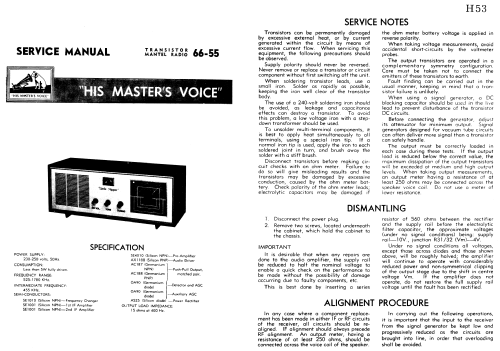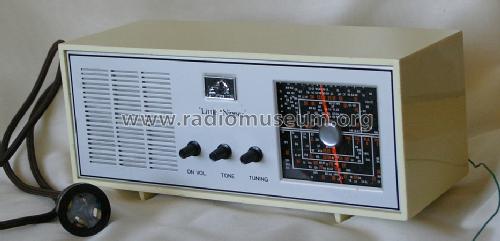Little Nipper 66-55
His Master's Voice (HMV, H.M.V.), EMI (Australia) Ltd.; Sydney, NSW
- Paese
- Australia
- Produttore / Marca
- His Master's Voice (HMV, H.M.V.), EMI (Australia) Ltd.; Sydney, NSW
- Anno
- 1968–1970
- Categoria
- Radio (o sintonizzatore del dopoguerra WW2)
- Radiomuseum.org ID
- 229176
Clicca sulla miniatura dello schema per richiederlo come documento gratuito.
- Numero di transistor
- 7
- Principio generale
- Supereterodina (in generale); ZF/IF 455 kHz
- N. di circuiti accordati
- 5 Circuiti Mod. Amp. (AM)
- Gamme d'onda
- Solo onde medie (OM).
- Tensioni di funzionamento
- Alimentazione a corrente alternata (CA) / 230-250 Volt
- Altoparlante
- AP magnetodinamico (magnete permanente e bobina mobile) / Ø 4 inch = 10.2 cm
- Materiali
- Plastica (non bachelite o catalina)
- Radiomuseum.org
- Modello: Little Nipper 66-55 - His Master's Voice HMV, H.M.V.
- Forma
- Soprammobile compatto/con bordi arrotondati/midget senza pulsantiera/tastiera.<= 35 cm (Sometimes with handle but for mains only).
- Dimensioni (LxAxP)
- 310 x 135 x 125 mm / 12.2 x 5.3 x 4.9 inch
- Annotazioni
-
This is a "Domestic Use" mantle radio which would have satisfied most urban users of the era. With 4 transistors in the AF stage driving a push/pull output pair of germanium transistors with a 22 Volt supply into a 15 Ohm speaker without an audio output transformer, the audio output would have been average or above for a Mantle Radio of its era. The Ferrite Rod antenna with 140mm shows that it was not aimed at the DX market and there is only the single tuned RF stage and oscillator before the IF stages. The frequency range is 525 to 1780 kHz.
Interestingly, the case still incorporates the full ventilation from a valve radio of the same era.
All metal parts penetrating the case, including the two screws that secure the chassis to the case, are earthed via the power cord, so this radio would pass modern safety checks unlike many of its contemporaries.
It is a "transition" model with silicon transistors in the RF/IF stages but germanium transistors in the AF/output stages. It still bears the "Little Nipper" designation which the 68-55 drops.
Plastic cabinet colours in Red, Tan & Charcoal.
See also later version HMV Little Nipper 68-55, which is electrically indentical.
- Prezzo nel primo anno
- 55.00 AUS $
- Letteratura / Schemi (1)
- - - Manufacturers Literature (HMV Service Manual for Model 66-55, May 1968.)
- Letteratura / Schemi (2)
- J.R. Publications Transistor Radio Service Handbook (Group C6, 1969, Page H53.)
- Autore
- Modello inviato da Brian Wilson. Utilizzare "Proponi modifica" per inviare ulteriori dati.
- Altri modelli
-
In questo link sono elencati 587 modelli, di cui 407 con immagini e 284 con schemi.
Elenco delle radio e altri apparecchi della His Master's Voice (HMV, H.M.V.), EMI (Australia) Ltd.; Sydney, NSW
Collezioni
Il modello Little Nipper fa parte delle collezioni dei seguenti membri.
Discussioni nel forum su questo modello: His Master's Voice: Little Nipper 66-55
Argomenti: 1 | Articoli: 1
This model marks a transition point for HMV Australia. There are a series of radios which share the same case with different fascias and in one instance, a different case.
The series appears to start with the 66-55 Little Nipper and then there is the HMV (NZ) Sprite which uses the same circuit and fascia as the 66-55 but with a timber (veneered particleboard) case. These use silicon transistors in the RF and IF stages but germanium in the AF stages. The transistor count is 7 with three diodes. Next appears to be the 67-55 which is a clock radio but without the Little Nipper designation, a different fascia but still uses germanium transistors in the AF stages. Next, at least numerically, is the 68-55 which uses the same case, fascia and AF stages but without the clock. Interestingly, the internal chassis behind the fascia has the cutout for the clock and some of the cases I have owned do have the hole in the back for the time and alarm adjusting shaft to protrude. Next is the all silicon transistor 68/2-55. The transistor count climbs to 8 and the 3 diodes remain.
Transistor useage seems to vary with availability. Those which I have seen are listed as "equivalent" in many reference books. The output pair can be mounted on different heatsinks, some large and some small. The 68/2-55 with a silicon output transistor pair uses no heatsinking.
The Sprite uses different transistors to the Australian 66-55 but the passive components do not vary. The circuit board is different in detail only, not in function.The Sprite uses a 200 mm long ferrite rod antenna whereas the Australian radios use one only 140 mm long.
Interestingly, these radios also have the Mains (240 volt) supply switched so that the transformer is not "live" at all times as was common in earlier transistor mantel radios from many manufacturers. These radios can pass modern Test & Tag standards.
With the New Zealand Sprite can be clearly seen the 3 core flat power cable that would make me uneasy for safety certification; it is not double insulated.
Allegati
- Siblings, cosoins or... (172 KB)
Brian Wilson, 08.Sep.22















